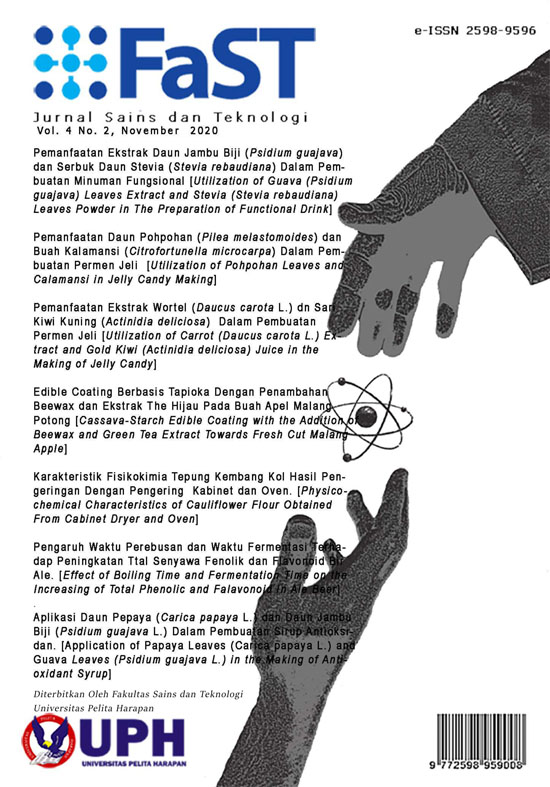EDIBLE COATING BERBASIS TAPIOKA DENGAN PENAMBAHAN BEESWAX DAN EKSTRAK TEH HIJAU PADA BUAH APEL MALANG POTONG [Cassava-Starch Edible Coating with the Addition of Beewax and Green Tea Extract Towards Fresh Cut Malang Apple]
##semicolon##
apple##common.commaListSeparator## beeswax##common.commaListSeparator## edible coating##common.commaListSeparator## edible film##common.commaListSeparator## fresh-cut##common.commaListSeparator## green tea extract要旨
Fresh-cut fruits are a type of food product which has seen an increase in recent years, because of its practicality. However, some disadvantages such as short shelf-life and rapid deterioration of quality persists. One such solution to increase shelf-life and inhibit deterioration of fresh-cut fruits are usage of edible coating, which is a type of packaging meant to be eaten with the food itself. Usage of additional components can be utilised to better the properties of edible coating. This research was aimed to create an edible coating from tapioca starch with addition of beeswax and green tea extract to increase its value and application towards fresh-cut malang apple. A variation of several concentrations of green tea extract (0.25%, 0.5%, 0.75%, 1%) and beeswax (0.25%, 0.5%, 0.75%) were used to create an edible coating and observe its effect on fresh-cut malang apple. Addition of green tea extract and beeswax in edible coating are meant to improve Water Vapor Transmission Rate (WVTR), tensile strength, elongation, and thickness properties. Edible coating with addition of 0.75% green tea extract and 0.5% beeswax was chosen to be applicated to fresh-cut malang apple. The use of such edible coating was found to inhibit deterioration of quality in fresh-cut malang apple in cold and room temperature storage.
Abstrak
Buah potong merupakan salah satu produk pangan yang mengalami peningkatan dalam beberapa tahun terakhir, karena kepraktisannya. Beberapa kelemahan dari buah potong yaitu umur simpan yang singkat dan penurunan kualitas yang cepat. Salah satu cara untuk meningkatkan umur simpan dari buah potong dengan penerapan edible coating, yaitu proses pengemasan terhadap produk pangan yang aman dikonsumsi bersama produk. Penggunaan komponen tambahan dapat meningkatkan kualitas dan memperbaiki kualitas edible coating. Tujuan dari penelitian ini adalah untuk membuat edible coating berbasis tapioka dengan penambahan beeswax dan ekstrak teh hijau untuk meningkatkan nilai guna dari edible coating dan pelapisan terhadap apel malang potong. Pada penelitian ini dilakukan variasi konsentrasi penambahan ekstrak teh hijau menggunakan air (0,25%, 0,5%, 0,75%, 1%) dan beeswax (0,25%, 0,5%, 0,75%), serta pelapisan pada buah apel malang potong untuk melihat pengaruh dan juga perubahan mutu yang terjadi. Penambahan ekstrak teh hijau dan beeswax berfungsi untuk memperbaiki kualitas dari sifat edible coating dari segi aktivitas antioksidan, total kandungan fenolik, laju transmisi uap air, kuat tarik, elongasi, serta ketebalan. Edible coating dengan formulasi penambahan ekstrak teh hijau 0,75% dan beeswax 0,5% dipilih sebagai formulasi terbaik digunakan dalam pelapisan pada buah apel malang potong. Pelapisan edible coating pada buah apel malang potong dapat menghambat penurunan kualitas sebesar 40% yang terjadi selama masa penyimpanan dalam suhu ruang (27°C) maupun suhu dingin (5°C).
##submission.downloads##
出版済
巻号
セクション
##submission.license##
“Authors who publish with this journal agree to the following terms:
1) Authors retain copyright and grant the journal right of first publication with the work simultaneously licensed under a Creative Commons Attribution License (CC-BY-SA 4.0) that allows others to share the work with an acknowledgement of the work's authorship and initial publication in this journal.
2) Authors are able to enter into separate, additional contractual arrangements for the non-exclusive distribution of the journal's published version of the work (e.g., post it to an institutional repository or publish it in a book), with an acknowledgement of its initial publication in this journal.
3) Authors are permitted and encouraged to post their work online (e.g., in institutional repositories or on their website). The final published PDF should be used and bibliographic details that credit the publication in this journal should be included.”





